
About UsThe Numismatic Bibliomania Society is a non-profit organization promoting numismatic literature. For more information please see our web site at coinbooks.org SubscriptionsThose wishing to become new E-Sylum subscribers (or wishing to Unsubscribe) can go to the following web page link MembershipThere is a membership application available on the web site Membership Application To join, print the application and return it with your check to the address printed on the application. Membership is only $15 to addresses in the U.S., $20 for First Class mail, and $25 elsewhere. For those without web access, write to: David M. Sundman, Secretary/TreasurerNumismatic Bibliomania
Society AsylumFor Asylum mailing address changes and other membership questions, contact David at this email address: dsundman@LittletonCoin.com SubmissionsTo submit items for publication in The E-Sylum, just Reply to this message, or write to the Editor at this address: whomren@coinlibrary.com
BUY THE BOOK BEFORE THE COINYou won't regret it! |
- WAYNE'S WORDS: THE E-SYLUM FEBRUARY 8, 2009
- HOWARD DANIEL WILL MAN A TABLE FOR NBS AT THE MARCH 2009 PORTLAND ANA SHOW
- DAVID FANNING NUMISMATIC LITERATURE'S THE BOOKSHELF: VOLUME 1, NO 1
- KOLBE NUMISMATIC LITERATURE SALE #109 CATALOGS AVAILABLE
- ORVILLE J. GRADY NUMISMATIC LITERATURE ISSUES INVENTORY LIST
- NEW BOOKS: ANS COAC: NEWBY’S ST. PATRICK COINAGE
- HARDBOUND GOLD COINS OF THE CHARLOTTE MINT AVAILABLE
- NEW BOOK: U.S./PHILIPPINE COINS BY LYMAN L. ALLEN
- THE JOHN W. ADAMS COLLECTION OF INDIAN PEACE MEDALS
- MORE ON THE CHICAGO COIN COMPANY NUMISMATIC LIBRARY
- AMERICAN NUMISMATIC SOCIETY MAGAZINE WINTER 2008 ISSUE
- HUNTOON ARTICLE ON COL. GREEN IN JANUARY/FEBRUARY 2009 PAPER MONEY
- QUERY: NUMISMATIC BOOK BINDER TYPOS
- COMPLETE COLLECTION OF EARLY DATE LARGE CENT DIE VARIETIES TO BE DISPLAYED
- QUERY: NUMISMATIC LITERATURE INVENTORY SHEETS
- QUERY: THE MYSTERY OF HENRY MORGAN: A NUMISMATIC DETECTIVE STORY
- MORE ON EARLY U.S. COINS ENCAPSUATED IN GLASSWARE
- MORE ON THE POTENTIAL SALE OF THE ROYAL COLLECTION OF HANNOVER
- WHEN THEY SAY "HERE COME DA JUDGE", THEY COULD BE TALKING ABOUT YOU!
- QUERY: NUMISMATIC USES FOR DIGITAL PANORAMIC CAMERAS
- DO LAX FEDERAL ARCHIVING POLICIES IMPERIL U.S. MINT RECORDS?
- ZIMBABWE REVALUES ITS WORTHLESS CURRENCY, DROPPING TWELVE ZEROS
- ABRAHAM LINCOLN'S 200TH BIRTHDAY IS THURSDAY, FEBRUARY 12, 2009
- THE NEW YORK TIMES ON ABRAHAM LINCOLN AND HIS CENT
- THE MYSTERY OF THE COUNTERFEIT CHRYSANTHEMUMS
- MUSEUM OF AMERICAN FINANCE SEEKS NEW DIRECTOR
- FEATURED WEB PAGE: ON THE TRAIL OF KING FAROUK
WAYNE'S WORDS: THE E-SYLUM FEBRUARY 8, 2009
 Among our recent subscribers are Bob Van Arsdell, courtesy of John and Nancy Wilson, Ray Czahor, and James Martin. Welcome aboard! We now have 1,232 subscribers.
Among our recent subscribers are Bob Van Arsdell, courtesy of John and Nancy Wilson, Ray Czahor, and James Martin. Welcome aboard! We now have 1,232 subscribers. This week we open with an update from Howard Daniel on his plans for representing NBS at a club table at next month's Portland ANA convention. Next we have updates on literature dealers Fanning, Kolbe and Grady. In new books, topics include Mark Newby coinage and U.S./Philippine coins.
In topics from previous issues, we have new information and comments on the Chicago Coin Company numismatic library, and coins encapsulated in glassware. To learn which U.S. coin resembles “the ignoble Emperor Vitellius with a goiter" (and which collector owned a diamond-studded chastity belt), read on. Have a great week, everyone!
Wayne Homren
Numismatic Bibliomania Society
HOWARD DANIEL WILL MAN A TABLE FOR NBS AT THE MARCH 2009 PORTLAND ANA SHOW
Numismatic Bibliomania Society (NBS) member Howard A. Daniel III, will be manning a club table for NBS (and IBNS, NI & PCF) at the American Numismatic Association National Money Show in Portland. There is a map to the convention center at www.money.org. There will be about 400 free packets with world coins from NI and a banknote from IBNS to be given to young and new numismatists at the club table. And references donated by NBS members and members of other societies will also be given to scout counselors to assist their scouts in earning a numismatic merit badge, and to teachers for their Coins in the Classroom events.Howard will be the moderator of the International Bank Note Society (IBNS) meeting Saturday morning (March 14) at 11AM in a meeting room described in the show program and all NBS members are welcome to join it. All NBS members are welcome and should bring something from home or bought on the bourse to describe during the show and tell part of the meeting.
There is often a Mini-Fest during the last 15 minutes of the IBNS meeting but Howard has not yet notified about one. This part of the meeting is conducted by collectors of Military Payment Certificates (MPC) and other military financial instruments and Military Fest Certificates (MFC) are usually "paid" to the attendees. Whether you are a collector of militaria or not, you will enjoy the Fest.
Howard will also be the moderator for an NI meeting at 12PM (Noon) in the same meeting room. All NBS members are welcome and should bring something from home or bought on the bourse to describe during the show and tell part of the meeting.
There will be a footlocker-sized amount of references shipped out by Howard to be given out at the club table in the name of NBS. If any NBS members would like to contribute some old/duplicate general references to NBS to give out at this and future shows, please bring them to the club table. Otherwise, you can contact Howard at HADANIEL3@MSN.COM and arrange for the transfer at a future show or to ship them to him.
The club table on the bourse can be designated as a meeting place for NBS members and members can also volunteer to man it so Howard can look around the bourse and attend other meetings. Howard is looking forward to meeting new and old NBS members in Portland!
DAVID FANNING NUMISMATIC LITERATURE'S THE BOOKSHELF: VOLUME 1, NO 1
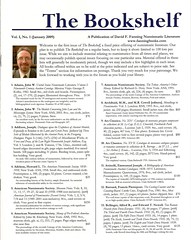 The first issue of David Fanning's new fixed price list of numismatic literature arrived a couple weeks ago. The eight-page self-covered pricelist offers exactly 100 items ranging in price from $22 to $3,200.
The first issue of David Fanning's new fixed price list of numismatic literature arrived a couple weeks ago. The eight-page self-covered pricelist offers exactly 100 items ranging in price from $22 to $3,200. Printed on high-quality glossy paper, the list features a few photographs, including the hirsute bookseller himself. The list is available online as well as in hardcopy, and many items are still available.
For more information, see: www.fanningbooks.com/the_bookshelf
KOLBE NUMISMATIC LITERATURE SALE #109 CATALOGS AVAILABLE
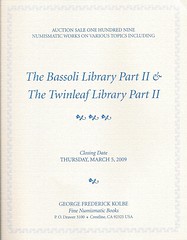 On March 5, 2009, Kolbe’s 109th sale will feature Part II of both of the above libraries. The auction will also include classic works on historical medals and ancient numismatics; Du Bois’s rare 1846 Pledges of History, the first work on the coin collection at the Philadelphia Mint; numismatic wall art; works on British numismatics; numismatically oriented Acts of Parliament 1695-1883; a little-known 1974 special convention issue of the Red Book; a 1799 Act of Parliament authorizing Matthew Boulton to erect a mint in Russia; and many other notable works on a variety of topics. Printed catalogues are available for $10 or are accessible at no cost at the firm’s web site: www.numislit.com
On March 5, 2009, Kolbe’s 109th sale will feature Part II of both of the above libraries. The auction will also include classic works on historical medals and ancient numismatics; Du Bois’s rare 1846 Pledges of History, the first work on the coin collection at the Philadelphia Mint; numismatic wall art; works on British numismatics; numismatically oriented Acts of Parliament 1695-1883; a little-known 1974 special convention issue of the Red Book; a 1799 Act of Parliament authorizing Matthew Boulton to erect a mint in Russia; and many other notable works on a variety of topics. Printed catalogues are available for $10 or are accessible at no cost at the firm’s web site: www.numislit.comLot 861 “Mr. Adam Eckfeldt, formerly Chief Coiner, led as well by his own taste as by the expectation that a conservatory would some day be established, took pains to preserve master-coins of the different annual issues of the Mint”
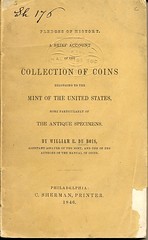 861 Du Bois, William E. PLEDGES OF HISTORY. A BRIEF ACCOUNT OF THE COLLECTION OF COINS BELONGING TO THE MINT OF THE UNITED STATES, MORE PARTICULARLY OF THE ANTIQUE SPECIMENS. by William E. Du Bois, Assistant Assayer of the Mint, and one of the authors of the manual of coins. Philadelphia: C. Sherman, Printer, 1846. 138 pages, 3 blank leaves, finely engraved medal ruling machine frontispiece plate depicting a variety of ancient Greek, Roman, and Byzantine coins. 16mo: 17 x 10.5 cm. Original printed tan wrappers a little worn, spotted, and dusty, portions of text a trifle foxed. An unsophisticated very good or better example, with honest signs of use. (1,250.00)
861 Du Bois, William E. PLEDGES OF HISTORY. A BRIEF ACCOUNT OF THE COLLECTION OF COINS BELONGING TO THE MINT OF THE UNITED STATES, MORE PARTICULARLY OF THE ANTIQUE SPECIMENS. by William E. Du Bois, Assistant Assayer of the Mint, and one of the authors of the manual of coins. Philadelphia: C. Sherman, Printer, 1846. 138 pages, 3 blank leaves, finely engraved medal ruling machine frontispiece plate depicting a variety of ancient Greek, Roman, and Byzantine coins. 16mo: 17 x 10.5 cm. Original printed tan wrappers a little worn, spotted, and dusty, portions of text a trifle foxed. An unsophisticated very good or better example, with honest signs of use. (1,250.00)Ex libris Harry W. Bass, Jr. Attinelli page 107. Clain-Stefanelli 12515. A pioneering work, comprising the first listing of the contents of the Mint Cabinet. The introduction features the author's evocative statement: "The collection was commenced in June, 1838. Long before that date, however, Mr. Adam Eckfeldt, formerly Chief Coiner, led as well by his own taste as by the expectation that a conservatory would some day be established, took pains to preserve master-coins of the different annual issues of the Mint, and to retain some of the finest foreign specimens, as they appeared in deposit for recoinage."
A printed notice on the title verso reads in part: "By a private contribution, an edition of one hundred forty copies, in the present form, has been struck off, for distribution to such societies and individuals as would be likely to appreciate the subject. It has also been adorned by a vignette, through the generosity of Mr. Saxton and Mr. Longacre, artists." Pledges of History is rarely encountered today, suggesting that the edition of 140 copies was never fully distributed.
Lot 823
International
Coin Convention
January 3, 4, 5, 6, 1974
Deauville Hotel
823 Yeoman, R. S. THE RED BOOK OF UNITED STATES COINS — 1974 — A GUIDE BOOK OF UNITED STATES COINS. 27th revised edition. fully illustrated. catalog and valuation list — 1616 to date. by R. S. Yeoman. including . . . A brief history of American coinage. Early American coins and tokens. Early mint issues. Regular mint issues. Private, state and territorial gold. silver and gold commemorative issues. Proofs. Edited by Kenneth Bressett. Racine: Whitman Publishing Company, Inc., 1973. 256 pages, text illustrations of coins throughout. 12mo. Original red leather-grained boards, spine lettered in gilt, upper front cover lettered in gilt within a gilt panel, lower front cover stamped in gilt as above. Spine ends and corners a trifle worn, internally unmarked. A fine, bright example. (250.00)
Special Convention Issue. Among the earliest specially-stamped editions of the Red Book, presumably prepared by the 1974 Miami Coin Convention sponsors although the tint and intensity of the gold foil utilized in both impressions is quite similar as is their registration. Clearly, it was not carelessly executed. At present, this appears to be the only example known to have survived from what was apparently a one-time coin convention, presumably manned and attended in substantial part by overseas dealers and collectors with little interest in retaining a foreign value guide rendered useless when its annual successor appeared.
Perhaps five, fifty—pick any small number—were issued for presentation and/or promotional purposes. It was fortuitously obtained at the show, and recently re-discovered, by an American numismatist whose collecting genes prevailed, though he thought little of it at the time. A vague recollection suggests that it may have been obtained it as a door prize. Now named the Deauville Beach Resort, its promotional material recalls that “The Deauville, as it was then known, was the center of Miami Beach’s glamorous 60's lifestyle, where Frank, Dino and Sammy romped while John, Paul, George and Ringo made history.” And for a brief period in early 1974, as documented here, it was the home of the numismatically rich and famous.
ORVILLE J. GRADY NUMISMATIC LITERATURE ISSUES INVENTORY LIST
Orville J. Grady
Numismatic Literature Bought and Sold
705 Howard St.
Scribner, NE 68057
800-295-4846 www.gradybooks.com
PLEASE RESPOND TO: gradybooks@attglobal.net
NEW BOOKS: ANS COAC: NEWBY’S ST. PATRICK COINAGE
 Newby’s St. Patrick Coinage
Newby’s St. Patrick Coinage Edited by Oliver D. Hoover
ISBN 978-0-89722-306-5
Hardback, illus., Price US $125
This volume collects together the papers presented at the Coinage of the Americas Conference on Mark Newby and the St. Patrick coinage, held in 2007. The papers address a wide variety of questions that have dogged the study of the St. Patrick series since the eighteenth century. Included here are new approaches to the major problems of metrology, iconography, and chronology, as well as the divisive issue of who was actually responsible for the production of this enigmatic Irish coinage.
An important survey of the various forms of money used in America in the seventeenth century serves as a background for the circulation of the St. Patrick coinage in West Jersey, while the final paper offers a reassessment of Mark Newby and his importation of the coinage to America. An appendix presents all of the St. Patrick coins in the collection of the American Numismatic Society.
The Coinage of The Americas Conference is an annual meeting that provides a forum for exchange of knowledge on a selected theme in the numismatics of the western hemisphere. The contributors to this volume are Oliver D. Hoover, Philip L. Mossman, William Nipper, Brian J. Danforth, Louis E. Jordan, Roger S. Siboni, Vicken Yegparian, Robert Wilson Hoge.
This Pre-Publication Discount is available only for orders postmarked by April 15, 2009
To read the original press release, see: Newby’s St. Patrick Coinage (http://numismatics.org/wikiuploads/NewsEvents/COAC_NewbysPreOrder.pdf)
Such a list would also help clear up my confusion over this press release - it says the Newby conference was held in 2007, but the cover image lists a date of November 11, 2006. The confusion is likely a typo. -Editor
HARDBOUND GOLD COINS OF THE CHARLOTTE MINT AVAILABLE
The book is nicely bound in black cloth with a gold stamped spine and cover. It is 196 pages and extensively illustrated in color. There is an analysis of every coin produced at the Charlotte mint, chapters on how to collect, an overview of the history of the Charlotte mint and new research by David Ginsburg on Deposits of Gold at the Charlotte Mint and Officers of the Mint.
To order a copy, please send a check to me at PO Box 4383 Portland Oregon 97208.
NEW BOOK: U.S./PHILIPPINE COINS BY LYMAN L. ALLEN
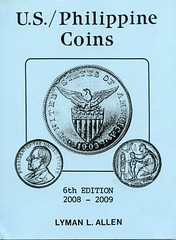
Ray Czahor
Cookie Jar Collectibles
Box 597
Columbia, MD 21045
Telephone: 301-604-9225
Email: cookiejarpi@verizon.net
THE JOHN W. ADAMS COLLECTION OF INDIAN PEACE MEDALS
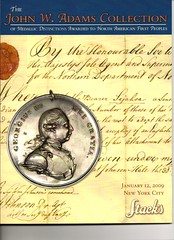 Better late than never - because of the press of the holidays I didn't get a chance to comment on the January 12th Stack's sale of the John W. Adams Collection of Medallic Distinctions Awarded to North American First Peoples. I understand there will be a hardbound version of the catalogue. I called and placed my order.
Better late than never - because of the press of the holidays I didn't get a chance to comment on the January 12th Stack's sale of the John W. Adams Collection of Medallic Distinctions Awarded to North American First Peoples. I understand there will be a hardbound version of the catalogue. I called and placed my order.The 71-lot sale is chockablock with interesting material - it's understandable how one could get pulled in to the important and fascinating history behind many of these medals. Below are images of lot 5059, the 1780 State of Virginia Happy While United Medal.
The final several lots consisted of "Documentary Distinctions and Official Correspondence" including George Croghan's account of his capture by a war party of Kecopoes and Musquetons. Ouiatonon, July 13, 1765 - a letter addressed to Alexander McKee, an agent at Fort Pitt.
I was astounded at the price realized - $2,645, which seems an absolute steal for such an historically important letter from the pre-revolutionary frontier. While I wouldn't expect a "mere" letter to bring the six-figure sums that some of the medals did, considering that the document is unique I wouldn't have been surprised to see if bring five figures. Hopefully it and the other auctioned documents found a good home with a researcher who will one day publish a new work on the subject.
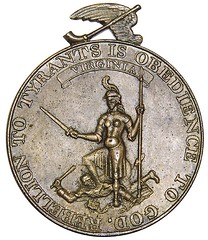
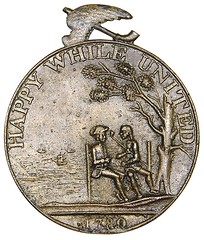
John Adams writes:
Thus, it was time for me to "get off the pot" and let others have a chance to own and research these medals. I am absolutely thrilled to report that that is exactly what happened. At least two of the purchasers at my sale - and hopefully, there are more - have mounted major efforts. I believe that my files have been of some help to these two and I would offer the same help to any of your readers that have a serious interest .
Indian Peace Medals are a fertile field for an abundance of work yet to be done. McLachlan, Morin, Belden, Prucha et al may have said the first words, but there is much more of the story to be told.
THE BOOK BAZARRE
MORE ON THE CHICAGO COIN COMPANY NUMISMATIC LIBRARY
Len Augsburger writes:AMERICAN NUMISMATIC SOCIETY MAGAZINE WINTER 2008 ISSUE
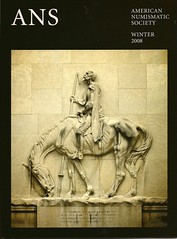 The Winter 2008 issue of American Numismatic Magazine has arrived, sporting a new look.
The Winter 2008 issue of American Numismatic Magazine has arrived, sporting a new look. The first issue published from the society's new location at 75 Varick Street in New York, the magazine's layout and look was redesigned by Rocco Piscatello. The society's web site has also recently undergone a redesign. It's a nice, clean look which maintains the high standard for color images throughout.
The magazine is now perfect bound, giving it a squared edge which has the title and issue number printed on it, all the better for shelving in one's library.
The featured articles in this issue are:
- "Truth and Plain Dealing" The Fate of the Archer Huntington Collection of Spanish Coinage by Robert Hoge, Andrew meadows and Ute Wartenberg Kagan
- "Better Late Than Never Newell Manuscript Finally Published
- Maximum Effort The ANS Moves to Varick Street
- Coin Collecting at Cambridge The Fitzwilliam Museum Department of Coins and Medals
The regular Departments include From the Executive Director by Ute Wartenberg Kagan, Library news by Elizabeth Hahn, Current Cabinet Artivities by Robert Hoge, From the Collections Manager by Elena Stolyarik, Book Reviews and Recent News.
One book review by Oliver Hoover covers A Pocketful of History by Jim Noles, a book on the U.S. State Quarter series mentioned earlier in The E-Sylum.
The magazine is a welcome addition to my library. I enjoyed reading all of the articles, and was delighted to see the article about the Fitzwilliam, which reminded me of my delightful visit there during my summer working on London. One needn't be an ANS member to get a subscription to the magazine.
For more information, see www.ansmagazine.com
HUNTOON ARTICLE ON COL. GREEN IN JANUARY/FEBRUARY 2009 PAPER MONEY
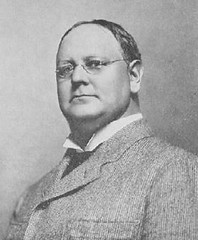 The January/February 2009 issue of Paper Money, the official journal of the Society of Paper Money Collectors (SPMC) has a great original article by Peter Huntoon on legendary collector Col. Edward H. R. Green.
The January/February 2009 issue of Paper Money, the official journal of the Society of Paper Money Collectors (SPMC) has a great original article by Peter Huntoon on legendary collector Col. Edward H. R. Green. Heir to the fortune of his mother Hetty Green, the infamous "Witch of Wall Street", Green was a man of large stature, and was "by every account a very personable, affable fellow, loyal, generous to his friends, not one to hold a grudge, passionate in his interests, and possessor of a fine sense of humor... Hetty died when Ned was 47, and he immediately made life style changes that materially improved his comforts. His collecting interests, apparently already established, blossomed." He assembled world-class collections of coins and paper money, as well as stamps, jewelry and naughty magazines. After his death in 1936, it took a convoy of eight armored cars escorted by state police and private guards to transport his collections.
Paper Money editor Fred Reed kindly forwarded a copy of the article so I could provide these excerpts for E-Sylum readers. The paper money connection? Green's collection of the serial number one Series of 1929 National Bank Note sheets. It's a great article, worth a year's membership alone. -Editor

He was so impressed with radio, he established his own radio station at Round Hill, which was one of the first to syndicate programs to other stations. His underlying interest was the life-saving potential of radio for safe passage of lost sea and airmen.
What proved to be highly unusual is that once the Colonel took possession of his Round Hill estate, he opened the grounds to scientists, mostly from MIT, and built the facilities they required right in his own back yard to carry on their research. This included a radio station with call letters WMAF ..., and a state of the art airfield complete with moorings and a hanger for the Goodyear blimp that was leased by MIT for aerial experiments conducted at Round Hill. The Colonel’s Round Hill Airport was a welcome gathering place for the elite pilots of the day, and he provided free fuel and services for those who landed there.
Obsolete research facilities were replaced with new as the needs of the research programs evolved. Much to the consternation of his neighbors, his estate looked more like a modern high tech industrial park built around an airport, than the manicured grounds of a member of the ultra rich.
A lawyer responsible for handling the Green estate is quoted as saying
But it’s strange, you know, how dull it all became after a few days. We welcomed a break like trying to identify an odd ornament - a diamond-studded chastity belt, for example.
Eric Newman writes:
It is Colonel Edward Howland Robinson Green and the World He Created at Round Hill by Barbara Bedell. It was published in 2003. It is a tribute to Col. Green's scientific research enthusiasm, his business acumen, his intellectual curiosity, his generosity, his friendships, problems with his mother and his inability to spend "the income on his income".
It was a revelation to me. It indicates that The Round Hill Estate, South Dartmouth, Massachusetts is now divided mostly into residential units. Unfortunately, nothing is said about his collections until after he died. I was so lucky to be able to acquire part of his numismatic holdings.
I would also like to know how to get the detailed report of the specific Byrd Antarctic Expedition during which the appendicitis operation was performed. Have you suggestion?
A member of Byrd's party came down with appendicitis. Eric and his fellow students manned the radio, sought out advice from doctors worldwide and relayed instructions that enabled a life-saving operation at 40 below zero.
A web search found a mention of the appendicitis operation on p110 of the book Footsteps on the Ice By Stuart D. L. Paine, M. L. Paine, published by University of Missouri Press, 2007. There are several mentions of the expedition radio operations in the book.
Now back to numismatics - after Green's death, young Eric managed to succeed where coin dealers across had failed miserably - he was able to purchase numismatic items from Green's estate. By partnering with dealer B.G. Johnson who fronted the money, Eric purchased a great deal of the collection including ALL FIVE of the legendary 1913 Liberty Head Nickels. -Editor
THE BOOK BAZARRE
QUERY: NUMISMATIC BOOK BINDER TYPOS
 It's bad enough when mistakes creep into a published work, but it's particularly embarrassing when errors occur on the binding. Let me know what examples you are aware of, and I'll compile a list.
It's bad enough when mistakes creep into a published work, but it's particularly embarrassing when errors occur on the binding. Let me know what examples you are aware of, and I'll compile a list. The topic came up a couple weeks ago at a meeting of my Northern Virginia numismatic social group, Nummis Nova. Mike Packard bought along a book to show everyone. I have a copy as well and I scanned an image of the cover. It's a special hardbound edition of Medals of the United States Assay Commission, originally published in the pages of the TAMS Journal, the official publication of the Token and Medal Society.
QUICK QUIZ: what's the mistake? (Click on the image to see a larger version on Flickr).
COMPLETE COLLECTION OF EARLY DATE LARGE CENT DIE VARIETIES TO BE DISPLAYED
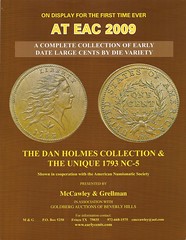 Attendees of the upcoming 2009 Early American Coppers convention (April 16-19 in Cincinnati, OH) will be treated to a rare display - a complete collection of early large cents by die variety, consisting of the Dan Holmes collection augmented by a loan from the American Numismatic Society of the unique 1793 NC-5 variety.
Attendees of the upcoming 2009 Early American Coppers convention (April 16-19 in Cincinnati, OH) will be treated to a rare display - a complete collection of early large cents by die variety, consisting of the Dan Holmes collection augmented by a loan from the American Numismatic Society of the unique 1793 NC-5 variety.The illustrated display announcement was distributed with the January 2009 issue of Penny-Wise, the official publication of Early American Coppers, Inc.
For more information, see www.eacs.org
QUERY: NUMISMATIC LITERATURE INVENTORY SHEETS
Ray Williams of Trenton, NJ writes:QUERY: THE MYSTERY OF HENRY MORGAN: A NUMISMATIC DETECTIVE STORY
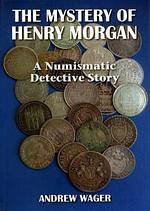 A numismatic detective story....
A numismatic detective story....As featured in the June 2008 issue of COIN NEWS this new book by Andrew Wager makes a fascinating read.
The year is 1811 - the country, bled dry by years of war with Napoleonic France and ruled by "Mad" King George, is facing a financial crisis with small coinage almost impossible to find. Enter Henry Morgan who manufactured private silver tokens and offered them as a solution to the economic woes - but all was not as it seemed.... Just who was Henry Morgan? Entrepreneur? Conman? Did he even really exists at all?
This new book takes a fresh look at one of numismatics most enduring mysteries...
Published 2007; Author Andrew Wager; 144 pp.
ISBN: 978-0-9557261-1-8
£18.00
To order a copy, see: www.tokenpublishing.com
MORE ON EARLY U.S. COINS ENCAPSUATED IN GLASSWARE
Clifford Mishler writes:When we passed through the city of Corning, as my wife has a liking for glass as a collectible, we decided to stop and explore the Corning Glass Museum. Therein I noted a goblet with an early 19th century U.S. coin encapsulated in its stem. While a subsequent contact with the folks at the museum provided me with some background material on such pieces, I have never been able to come up with an example myself, although my pursuit has been somewhat passive.
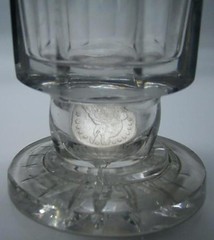

MORE ON THE POTENTIAL SALE OF THE ROYAL COLLECTION OF HANNOVER
Responding to the issue in the American Numismatic Society Yahoo group, Jorg Lueke wrote:
Secondly, I don't think the bank is at all uninformed about the scholarly value. Without the bank the scholarship of the last 25 years would not exist. The chief concern is the continued cost of maintaining and protecting the collection, is this a cost a single private entity should bear?
The possibility of a permanent loan or a purchase of the collection by the state of Niedersachsen are both on the table and would serve both to keep the collection intact while allowing the bank to be free of the cost of maintaining the collection.
R. G. Doty (Past President, ICOMON) writes:
The whole thing is perilous. If you ask "What do we need with a coin museum? We've got everything we need on the Web", we've probably lost you already. All I can say (and this is from the heart) is that there is and always will be a difference between binary images and the real thing. And I hope I never live to see the day when that's not true.
WHEN THEY SAY "HERE COME DA JUDGE", THEY COULD BE TALKING ABOUT YOU!
QUERY: NUMISMATIC USES FOR DIGITAL PANORAMIC CAMERAS
Dan Freidus writes:The equipment: http://gigapansystems.com/system-page.html
(under $400 and they’re about to come out with a less expensive version!)
The note: http://gigapan.org/viewGigapan.php?id=15209
The Inauguration: http://share.gigapan.org/viewGigapan.php?id=15374
Below is the image of a banknote, and below that is a close-up I zoomed in on. Wow! -Editor
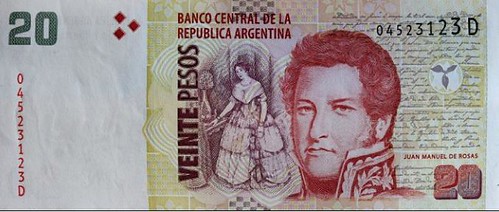
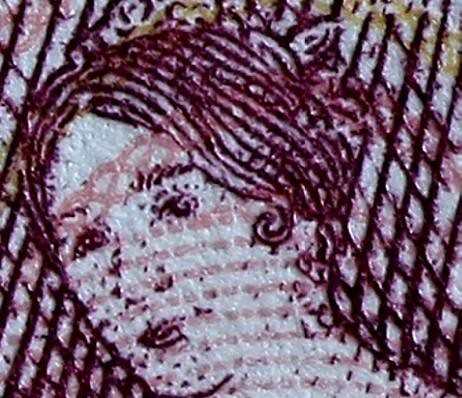
DO LAX FEDERAL ARCHIVING POLICIES IMPERIL U.S. MINT RECORDS?
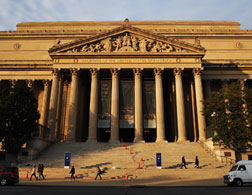 President Barack Obama's decision last week to revive the Freedom of Information Act was a good first step toward fulfilling his campaign pledge for a "new era of open government."
President Barack Obama's decision last week to revive the Freedom of Information Act was a good first step toward fulfilling his campaign pledge for a "new era of open government."Here's an idea for a good second step: Force the federal agencies to file and maintain all the records they're creating now, so that in the future when citizens file FOIA requests to declassify documents, they won't receive a form letter that reads, "Sorry, no such documents exist."
A 2005 report by the National Archives and Records Administration—which was declassified just this week under a FOIA suit filed by the National Security Archive, a private research organization at George Washington University—concluded that, in an era when nearly all records are stored on hard drives, rather than typed on paper, the raw bits of history are evaporating.
In June 2003, I wrote a Slate column, called "The End of History," that expressed some of these worries. I quoted at some length an Air Force historian named Eduard Mark, who had launched a one-man crusade to draw attention to this disaster. He remembered an incident from the early '90s, when he was researching the official Air Force history of the Panama invasion, which had taken place only a few years earlier. At the Air Force operations center, he found a small Mac computer on which officers had saved all the briefings. Someone was about to throw the computer out. Mark stopped him just in time and printed out the briefings. "Those printouts I made," he told me, "are the only copies in existence."
To read the complete article, see: PowerPoint to the People (http://www.slate.com/id/2209981/)
ZIMBABWE REVALUES ITS WORTHLESS CURRENCY, DROPPING TWELVE ZEROS
Gono also announced that the South African Rand would now trade at Z$2 while the US dollar would trade at Z$20.
The move was accompanied by the introduction of new currency denominations of $500, $100, $50, $20, $10, $5 and $1. The new denominations will co-circulate with the old currencies.
This means the current $100 trillion note will be equivalent to the re-valued $100 note; $50 trillion note to the re-valued $50 note and the current $10 trillion note to the re-valued $10 note and so on.
After June 30, the old family of denominations will cease to be legal tender.
To read the complete article, see: Reserve Bank drops 12 more zeros (http://www.thezimbabwetimes.com/?p=10832)
ABRAHAM LINCOLN'S 200TH BIRTHDAY IS THURSDAY, FEBRUARY 12, 2009
Expect to hear and read a lot about our 16th president between now and then. There are TV specials and tons of articles to appear in print. I expect to walk along the magazine racks at Barnes & Noble this week and see Lincoln staring at me from virtually every cover.
I got an internet offer 10 days ago from the Smithsonian Magazine. They have published a special collector's edition. Eight dollars postpaid. I couldn't type my credit card number fast enough. It arrived four days ago. In the magazine trade this is called a "one-shot." You don't receive it even if you are a Smithsonian subscriber. But I expect it will be on B&N racks.
It is filled with fifteen fabulous articles -- mostly from well known historians -- and tons of pictures. Great collectible. The cover is the most realistic photograph of Lincoln I have ever seen. I am tempted to slab it, I don't want the cover corners bent. And I hear the press run was under ten million!
The New York Times is covering the event, it seems like every day recently The article published February 8th "Now If Only We Could Mint Lincoln Himself" among its many articles. It quotes David Lange, Doug Mudd, ANA curator and numismatic author extraordinary, Dave Bowers. The Times has published over 100 articles on Abe Lincoln alone since June 2004. Many are book reviews or new publications on Lincoln.. Some editorialized about our idol, even commenting on how he would fit in today's culture and economy. A little like Doug and Dave did.
I have already pulled down from my library shelves all the books I have on Lincoln . I will peruse each again as my tribute on Thursday. Writing books on Lincoln never seems to end. It is more than a cottage industry. Sales of all these books might even exceed the gross national product of some small nation.
However each generation has the opportunity, nay -- the obligation, to interpret the famed president as new information is disclosed and great minds comment on this great man.
THE NEW YORK TIMES ON ABRAHAM LINCOLN AND HIS CENT
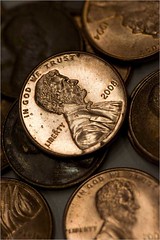 Emperors, kings and other authority figures had long projected their power by stamping their faces on loose change. In 1791, Congress was set to follow their example by impressing the likeness of our first head of state, George Washington, on our metal money. Succeeding presidents would appear on coins struck after they were elected.
Emperors, kings and other authority figures had long projected their power by stamping their faces on loose change. In 1791, Congress was set to follow their example by impressing the likeness of our first head of state, George Washington, on our metal money. Succeeding presidents would appear on coins struck after they were elected.But Washington argued against the idea, deeming it too “monarchical.”
“It smacked of royalty,” said David W. Lange, director of research for Numismatic Guaranty Corporation in Sarasota, Fla. “It was not a good omen for a new republic.”
So the Mint Act of 1792 mandated that there would instead “be an impression emblematic of liberty” on our standard coinage. On the front, this usually constituted an idealized, goddess-like figure. The solution was practical and patriotic enough to hold sway through the 19th century.
Unfortunately, this familiarity bred contempt. Artists at the United States Mint took the liberty motif so much for granted that some of their designs grew dowdy and uninspired. In 1892, one newspaper declared that the liberty image that Charles Barber, the mint’s chief engraver, had put on the country’s new dime, quarter and half-dollar resembled “the ignoble Emperor Vitellius with a goiter.”
President Theodore Roosevelt had his own thoughts. In 1904, he complained to Secretary of the Treasury Leslie Mortimer Shaw, “Our coinage is artistically of atrocious hideousness.”
In 1908, Roosevelt suggested that the Lithuanian-born sculptor Victor David Brenner, who had created a Lincoln plaque that the president admired, replicate his handiwork on a circulating coin. Early in 1909, Mr. Brenner wrote to the mint’s director, Frank A. Leach, that an image of Lincoln would “compose very well” on our one-cent piece.

This year, the mint is releasing a series of four new images on the reverse of the Lincoln cent, each one depicting a different stage of Lincoln’s life. Mint officials hope that the novelty might generate some of the popularity that greeted its recent 50 State Quarters program.
Mr. Bowers said he thought that the economy, the new administration, and other current events have overshadowed this radical redesign.
“If the timing had been different,” he said, “the news about the Lincoln reverses would have been on the front page of USA Today.”
To read the complete article, see: Now if Only We Could Mint Lincoln Himself (www.nytimes.com/2009/02/08/weekinreview/08vinciguerra.html?_r=1)
THE MYSTERY OF THE COUNTERFEIT CHRYSANTHEMUMS
A lawsuit filed here this morning demands resolution of the mystery: Did the Japanese police uncover the biggest and most well-financed counterfeit operation in history, or instead commit a major blunder by seizing 103,000 genuine gold coins as fake and incorrectly accusing a Briton of dealing in them?
Paul Davies, the British coin dealer at the center of this strange affair, insists that several thousand of the coins confiscated from him two years ago are genuine. In his suit, Mr. Davies demands that the coins be returned, or that he be paid for their full value, plus interest.
The suit is intended to force the police to do something they have failed to do for the last two years -- prove the gold coins are indeed counterfeits.
The mystery first became public in February 1990, when the Finance Ministry said it had discovered 103,000 counterfeit gold coins. They are said to have appeared among the 11 million special coins the Government minted in 1986 and 1987 to commemorate the 60th year of the reign of Emperor Hirohito, known posthumously as Emperor Showa.
The coins actually served several purposes. They were regarded as a fitting way to mark the Emperor's long rule and Japan's emergence in the 1980's as an economic powerhouse. But they were also a major money-making enterprise. An Official Gold Rush
There was a gold fever in Japan at that time, and the coins, slightly larger than a quarter, with the Imperial chrysanthemum symbol stamped on one side, were eagerly snapped up by collectors.
The Finance Ministry took advantage of that fervor by giving each coin a face value of 100,000 yen (about $778 at today's currency rates), the price at which they were sold and could be redeemed. But the coins included what was then only about 40,000 yen worth of gold each. That meant the Government earned about 60,000 yen on each coin it sold, a total of some $5 billion if all went well.
The markup also meant that if some clever forger could manage to buy tons of gold, refine it to the unusually pure level of 99.99 percent used by the Japanese Government, and mint exact replicas, he or she could also claim these extraordinary profits.
It has been reported, however, that almost a million of the official coins went unsold. And that is where the story gets interesting.
Mr. Davies, a voluble man who acknowledges that gold moves in strange ways, and who is clearly relishing a showdown with the Japanese authorities, has his own theory.
He has commissioned three reports by one of Europe's top anti-counterfeit experts, Ernest Newman, which insist without the slightest doubt that the coins are genuine. Microscopic striations that the Japanese contend are proof of the forgery are actually marks from the very dies the Government used to mint the coins, Mr. Davies and Mr. Newman contend.
Mr. Davies has theorized that the suspect coins came from the Government's unsold lot of nearly a million coins.
To read the complete article, see: Numismatic Mystery: A New Turn in the Case of the Chrysanthemum Coins (http://query.nytimes.com/gst/fullpage.html?
res=9E0CE7DD1330F933A15756C0A964958260)
MUSEUM OF AMERICAN FINANCE SEEKS NEW DIRECTOR
Lee Kjelleren, who joined the Museum as executive director in 2004, informed the board he will step down from the president/CEO position in June. Under Mr. Kjelleren’s stewardship, the Museum expanded from a modest one-room gallery at 26 Broadway to 30,000 sq. ft. of space in the former headquarters of the Bank of New York at 48 Wall Street, where it opened on January 11, 2008.
“Lee’s great accomplishment has been to bring the Museum to its splendid new home at 48 Wall Street, re-designing it for an exciting future,” said Museum Chairman John E. Herzog. “This required tremendous thoughtful effort, and the board appreciates this contribution greatly.”
About the Museum of American Finance
The Museum of American Finance, an affiliate of the Smithsonian Institution, is the nation’s only public museum dedicated to finance, entrepreneurship and the free open market system. With its extensive collection of financial documents and objects, its seminars and educational programming, and its publication and oral history programs the Museum portrays the breadth and richness of American financial history, achievement and practices. The Museum is located at 48 Wall Street, at the corner of William Street, and is open Tuesday – Saturday, 10 am – 4 pm. Interested applicants should send a resume and cover letter to humanresources@financialhistory.org. For more information, visit www.moaf.org.
To read the complete article, see: Museum of American Finance Announces Search for New Director (www.moaf.org/news/press_releases/000014)
FEATURED WEB PAGE: ON THE TRAIL OF KING FAROUK
This week's Featured Web Page is an article by Carl Lester titled Numismatic "Gumshoe:" On the Trail of King Farouk. It's a great piece of writing detailing Carl's detective work in tracking down a Dahlonega gold coin from the 1956 Farouk sale. Numismatic literature provided the signposts on Carl's tour, beginning with a copy of the Farouk sale catalog. Click the link and give it a good read!After reading about the "cloak and dagger" surrounding the King Farouk auction, I was fascinated! I wanted to acquire a King Farouk piece that would fit my specialty, Dahlonega gold coins.
One of the items that I acquired in Baltimore was an original copy of the coins and medals volume of The Palace Collections of Egypt , obtained from numismatic literature dealer Charles Davis.
One item from the first Champa sale really piqued my interest. It was lot 493, dealer Sol Kaplan's "sales room copy" of The Palace Collections of Eqypt coins and medals catalog, magnificently bound, presumably by Alan Grace, in green half morocco. Most importantly, Mr. Kaplan had recorded the buyers of the lots in the American section of the sale. What an important research tool this would be!
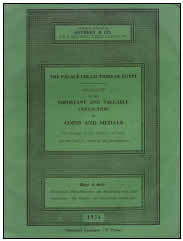
www.goldrushgallery.com/news/gumshoe.html
